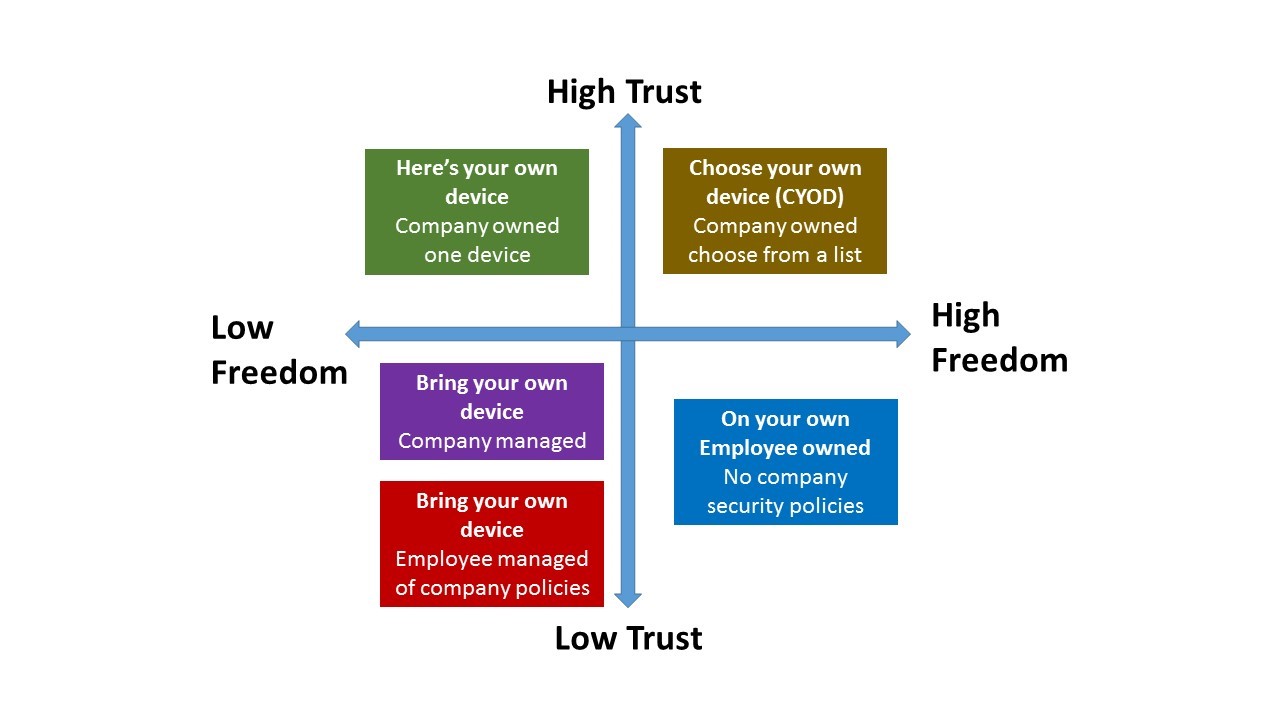Explore the Microsoft device strategy framework
Device Registration enables users to access internal company websites and company apps from devices without having to enter user credentials each time. Device Registration also enables administrators to have some control over the devices, such as controlling the web apps that users can access from devices that are enabled for Device Registration.
Variations in both ownership and management of the devices that make it necessary to expand the BYOD scenario to include the four core scenarios shown below. These scenarios comprise the Microsoft Device Strategy Framework.

The scenarios shown above can be summarized as follows:
On your own. In this model, employees provide their own devices. There are no security policies in place, no organizational management of the device, and any device is acceptable. This is a very open approach, but it presents the highest security risk.
Bring your own device. This model includes two distinct variations on policy management:
- Bring your own unmanaged device. In this model, employees provide their own devices, but as part of the company policy, the company does not manage those devices. The employees are responsible for implementing and managing company policies on their devices. This is a flexible policy but it presents security risks; some businesses might not have the resources to manage these risks.
- Bring your own managed device. This is the most traditional format for BYOD. In this model, employees provide their own devices and the company enforces its policy to allow the devices to access company data. The device is fully managed by the company.
Choose your own device (also called CYOD). In this model, the company provides a mobile device to employees so those employees can perform their jobs remotely. The company often allows employees to choose from a list of approved devices that are fully compatible with the company’s apps and management infrastructure.
Here’s your own device. In this model, the company has one device approved for the company’s mobile platform and this device is provided to employees.
The landscape for enterprise mobility extends well beyond BYOD; you cannot assume enterprise mobility means BYOD only. There are many more elements that must be covered to completely embrace mobility and enable a mobile workforce. Each scenario has advantages and disadvantages that vary according to company requirements and goals.
Mobile users today expect to move easily across devices, on their own terms, without having to learn new tools or interrupt their familiar work practices. We have seen in our enterprise engagements that consumer and employee expectations are driving these changes and forcing businesses to rethink how they win, serve, and retain customers and how they enable their mobile and work-at-home employees to stay productive. Your customers spend a good deal of their time on mobile apps and devices, and they expect you to meet them there in ways that accommodate their mobile lifestyle. This requires that you anticipate their needs and engage them at key moments with the right content and services.
Your employees require mobile access to their team members, resources, and core business processes to stay productive, and they expect you to make that a seamless experience. This requires that you enable new work processes and understand the expectations that mobile employees bring to the workplace. The commonality here is the concept of user-centric experiences. Mobile devices are already well tuned to personal preferences; the next step is to extend this personalization into business processes. Companies today are redesigning their operations to accommodate the mobile mind set of both customers and employees in order to achieve top line and bottom line business impact. The combination of engaging, personalized apps on the front end, and a scalable, secure cloud infrastructure on the back end makes that a reality.
The result will be a transformed enterprise, with opportunities for cost containment, new revenue streams, and potential new business models.